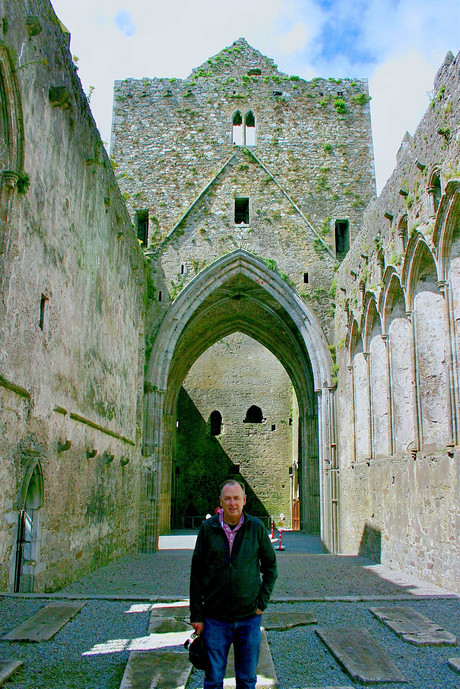A family connection, Well Worshipping and the Devils Bit...
- Fiona
- Sep 18, 2020
- 4 min read

We spent another day exploring parts of Tipperary (not such a long way there....) where we visited St Patricks Well and Cashel Rock as well as dropping in one afternoon to visit with Nicola Wade, her husband Robert and their son Alex. Nicola is a ‘cousin' on Alan's father’s side of the family hailing from County Cork. They live in the beautiful countryside close to Cashel.
Alan with Nicola and Robert
St Patricks Well
St Patricks Well is located beside a stream at the bottom of a limestone cliff.
The sign at the top of the steps reads...
“Before the advent of Christianity, in ancient Ireland, well worshipping was widely practised. The wells were from earliest times, popular assembly areas and also open-air centres of pagan worship. On later investigation we found that the water from the well was thought to cure sore lips, sore eyes and scrofula!
St Patrick (circa 5th Century AD) on his journey throughout the country, took advantage of these meeting places and adapted them to suit Christian worship – to preach the Gospel and baptise new converts. St Patricks Well, with its copious flow of water and fed by subterranean channels from underneath the limestone strata provides the earliest link with Christianity in the region.”
From the roadside we walked down a long set of winding steps to arrive at a very quiet glade that we had all to ourselves. As we neared the bottom of the steps, we passed a statue of St Patrick looking out to a large pond, a well and to a ruin of St Patricks Church.
The glade was quite beautiful - its Irish summer colours were fresh vivid greens of the grass, trees and shrubs, The sound of flowing water amplified the summer ambiance.
At the well, we could see the water bubbling up from an underground stream into a shallow gravel bottomed pool. The water from the pool overflowed through two stone culverts into a ‘Y’ shaped channel and then into the large pond with an early-Christian, Celtic-style cross in the centre. At the head of the well was a simple, plaque of Saint Patrick.
The church has been partially restored and incorporates the decorated tomb of Nicholas White of Clonmel who died in 1622 and it also has some finely restored Norman arches.
you can read more at Pilgrimage in Medieval Ireland and about Well worshipping here
.
Images
1-2 Views of St Patricks Church and the pond and cross as seen from the bottom of the steps
3 The stream that the water from the pond empties into
4-5 Statue of St Patrick
6-7 The Well and the plaque of Saint Patrick
8-11 St Patricks church ruin
12 Statue of the Child of Prague in the church at St Patrick's Well
13-14 St Patricks Church ruin
Rock of Cashel
While we’re talking about St Patrick......
Ireland’s tourism website tells us that the Rock of Cashel brings us the stories of ‘Ancient kings, patron saints and unparalleled beauty…stunning scenery...’ And they are so right!
Physically the Rock of Cashel is a prominent green hill, banded with limestone outcrops, rising from a grassy plain with ancient fortifications enclosing a round tower, a 13th-century Gothic cathedral and ta 12th-century Romanesque chapel. When we visited the chapel was closed but we were able to explore the ruins of the Cathedral and its grounds.
The Ancient Kings and Saint Patrick –
This landmark was an ancient royal site of the kings of Munster including Brian Boru (remember he was from Killaloe) who was crowned there in 1002 and even earlier in 432AD when St Patrick came to Cashel to baptise King Aengus who became Ireland’s first Christian ruler.
The origin of the Rock is also the stuff of myth and legend - that the Rock of Cashel appeared when the devil took a bite from the mountain known as the Devil's Bit, and spat it back out landing in the middle of Tipperary's countryside and so becoming the Rock of Cashel!
Putting aside the history of the Kings of Munster, St Patrick and that fabulous legend about the Devil, what we explored in late July was an impressive cluster of medieval buildings. Most of them date from the 12th and 13th centuries when the rock was gifted to the Church and are set on a dramatic outcrop of limestone with the town of Cashel at its base and vistas of the beautiful green fields of the surrounding countryside. More on the Rock of Cashel at https://www.irishtourism.com/rock-of-cashel
After a short downhill walk from the Rock, we wandered around Hore Abbey, a ruined Cistercian monastery which has its own story... initially a Benedictine abbey at Hore it was gifted (along with land, mills and other benefices previously belonging to the town) to the Cisterians by the Archbishop David MacCearbhaill (in 1270). One story is that he evicted the Benedictines after a dream that they were about to kill him but in reality it was probably due to the Archbishop's 'interference' with the commerce of the city of Cashel.
Images
1 The Rock of Cashel as viewed from the town side
2-3 The view of the Cathedral as you enter the complex
4-10 Various aspects inside the Cathedral
11-16 Graves on the Northern side of the Cathedral - I particularly liked the Celtic Crosses and the outside of the Cathedral
17-18 Vistas of the stunning Irish countryside - taken at the Cathedral
19 Looking back up the hill to the Cathedral as we went down to Hore Abbey
20-21 Turning around to see Hore Abbey
22-26 The Abbey ruins





















































































We loved Cashel, one of the nicest towns around the area, so walkable and lots of nice cafes and pubs